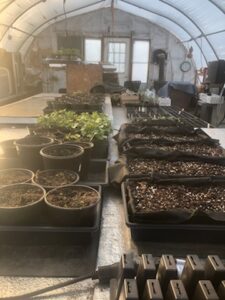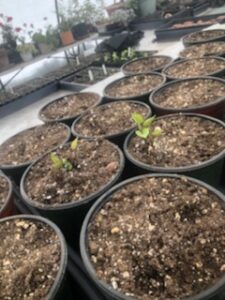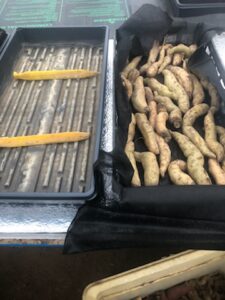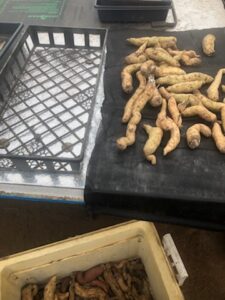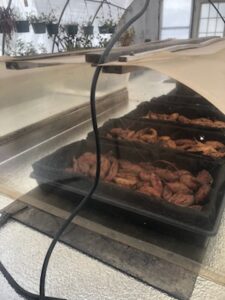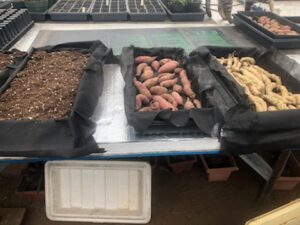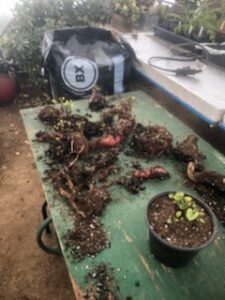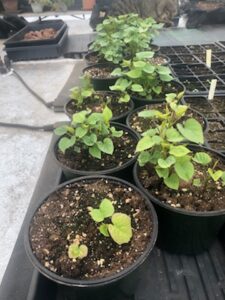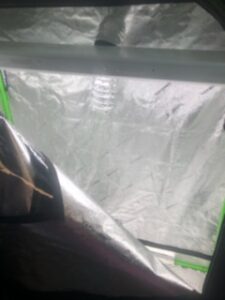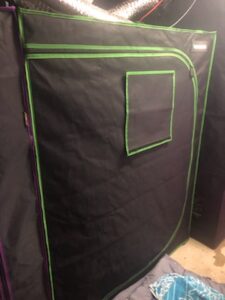Final report for FNE19-922
Project Information
Sweet potatoes are becoming a hot customer favorite at farmers markets, CSAs, and with restaurants but relying on purchased-in transplants from out of state had its problems. The issues most local farmers were having was poor survival rates. Producing NY- grown transplants was the answer but this needed to be commercially viable and we explored several methods to do so.
Tuber cuttings and slip production were compared for ease of production, rooting strength and survival. Survival rates both from my rooted cuttings and slips grown in six packs were high but slips were a bit easier to grow and establish during the process.
Time spent with each process of plug transplant production makes a difference if you are trying to grow hundreds or thousands of new plants. Slip production looked to save 15-20% more time and effort with a comparable end product as compared to cuttings.
The test would be having other farmers grow out the transplants in their fields and getting responses back about their experiences. through the Cornell Vegetable Program newsletter articles and correspondence with local small farmers, a dozen orders for plant came in. We followed up at the end of the seasons. The feedback was very positive, especially for one variety, Moen. The vine growth in the field was large and when adequate moisture was present the yields were averaging 4-8 medium sized tubers rather than one really large type and a bunch of small fingerlings. For 2021, two growers will be trying to grow their own slips from overwintered tubers in their storage based on the information provided from this project.
This project seeks to compare methods of growing sweet potato transplants on a larger commercial scale. The sweet potato varieties used are those that have become acclimated to the northern climate having been grown by the project leader for years. The methods will be tested against each other to see which is the most cost effective while producing quantities of high quality transplants that will be made available to growers in WNY to grow out at the time of the spring that fits their needs. After two seasons of trials, the successful method will be taught to other interested growers in a workshop.
The project is an investigations of cost effective techniques to produce high quality sweet potato transplants that WNY farmers will be willing to grow. The demand for sweet potatoes grown locally is increasing. Getting a strong start with sweet potato transplants is key for productive plants that take all season to produce tubers of medium size and plenty of them. Consumers and regional chefs seem to prefer medium sized roots over the larger ones found in most grocery stores. Sweet potatoes that have been grown in WNY tend to be one southern variety (Beauregard) and generally it produces one or two large tubers and a few small ones. From years of production and selection, four varieties have been grown on my produce farm that yield fairly uniform medium-sized tubers.Ordering slips from companies down South can be iffy when it comes to quality. Often, slips are shipped up north when they are ready under Southern climate conditions. This sometimes means slips are shipped to NY in the early spring. Some springs farmers here can get into the ground early. More common, however, is not being able to get into the ground till mid or late May. This means the slips are being held in less than ideal conditions. Root rot is a common problem and plant loss can be 10-25% before they ever get in the ground.
In a survey of growers selling fresh produce at area farmers markets by the project advisor, Robert Hadad, in 2017, 2 questions were asked concerning growing sweet potatoes. Why aren’t you growing sweet potatoes and if you are then what are the top two problems facing expansion for this crop. There were 89 farmers from 22 markets asked. The reason for not growing sweet potatoes was because they didn’t think the plants were productive enough especially if they had just one or two big tubers. The second reason was uncertainty of transplant date due to WNY weather and having to hold the transplants purchased from the south too long. Many complained that despite giving the plant nursery that they ordered from a preferred shipping
date, slips quite often would show up too early. A dozen growers commented that it would be great if they could purchase locally grown sweet potato slips because they could get them when they were ready to put them in the ground.
I’ve been gardening since I was about 4years old using Organic methods and at 71 years of age I am still doing it. But I have been growing sweet potatoes for only 4 or 5 years. I learned the process I use from an old farmer neighbor, and the varieties I grow also came from him. These varieties are Moen, Regal, and Ivone. Moen has orange skin and pointy leaves. Regal has red skin and broad leaves. Ivone has white skin and broad leaves.
My farm is 2.2 acres and has 3 greenhouses: small, medium, and large. I also have a number of raised beds for herbs, greens, and some root crops. I have several large garden plots. And I sell my produce at my farm stand.
Cooperators
- - Technical Advisor (Educator)
- - Technical Advisor (Educator and Researcher)
- - Technical Advisor (Educator and Researcher)
- - Technical Advisor (Educator and Researcher)
Research
I currently have 4 varieties of sweet potatoes that I have started in 10 gallon containers. These will be used to take cuttings from in late winter. I will also plant some of my stored sweet potatoes in late winter to take slips from. Because sweet potatoes are quite sensitive to cold, I have to keep them on heat mats.
As a test run, I'm going to remove potatoes from one of the containers and incubate them, forcing them to sprout. Using a heat mat with one regular tray and a second transport tray (plastic mesh), I will lay out removed potatoes in this tray setup and cover loosely with grow mix. Soak thoroughly initially and let set 2-3 hours and drain off excess water, place on heat mat. Cold frame has automatic venting when it gets too hot and I have a sensor that will show me the temperature and humidity, ideally 100% humidity and 90 degrees.
I have rooted cuttings from the Beauregard potato; I'd like to try growing it--it's a potato that grows fairly well in the North. I'd also like to try the variety Covington from Johnny's Selected Seeds.
Storage of the overwintering tubers is critical also. We need stored tubers to be in great shape for the formation of plants and shoots as part of the process of transplant production. Healthy tubers are required to be stored in warmer conditions than most winter storage crops. Temperatures need to be in the 60F range without large swings in temperature. To grow more transplants then we need more tubers in storage that will be held under ideal conditions.
The pots have potatoes planted inside and grown on mates inside the greenhouse. They sprouted quickly on the heat mat inside the greenhouse. These plants will be used for cuttings. The first photo also shows how much space is used up for starting sweet potato transplants in a small greenhouse.
Photos 1-8 below show the process for getting potatoes to sprout using a heat mat in the greenhouse. They also show some getting ready to transplant and some of the transplanted ones sprouting.
Photo 9-10 are the temperature and humidity control “chamber, inside and out. The chamber is used to cure and store sweet potatoes. Then after a period of time, the potatoes would be brought out of dormancy to sprout.
Over the course of the project, I have changed our technique for starting slips and cuttings from initial method (using sandwich bags cut in half, filled with small amount of soil and then the slip for cutting, wrapped in a piece of plastic garbage bag cut in strips--about 12-15 per roll). These were put in a container and left until planting. This technique had significant loss (approx. 10%) and was labor intensive. (This technique is similar to the method used by companies that ship their slips; according to my field representative, farmers experience similar loss with produces from these companies.)
My current technique (used last year) is to start cuttings in 3-inch deep plastic 6-packs (8 6-packs per flat), giving me 48 plants per flat. I use an all-purpose growing mix and place them on a heat mat. I had good success with this technique, reducing loss from 10% to 2%.
The project then compared producing “slips” vs taking cuttings for transplants. Slips are unrooted sprouts from tubers. Transplants are root plugs. Allowing the slips to root like the transplants allowed for larger (and already rooted) plugs. There were grown in 6 pack inserts with 48 to a tray. Having rooted cuttings ready to plant gave a huge advantage to growers for getting their crop started in the field. NY has a shorter growing season than the South where slips are produced. Our colder spring means getting plants into the ground later. Having rooted transplants with a leaf canopy already to go means the plants can get a quicker start. Quicker starts mean more tuber production and better harvests in the fall. Many trays of transplants were sold to growers and the harvest results reported back were that the tubers, especially Moen were terrific with great sales and consumer satisfaction. Two growers have expressed interest in growing their own inside of their greenhouses for 2021.
The COVID pandemic in 2020 upset the goals for that season. Many growers were unsure of their capability to even sell at some farmers markets and CSAs situations were in chaos. Very few orders for transplants were called in. Outreach was put on hold. The outreach plan for the results will be through articles in the Cornell Vegetable Program newsletter and posted on their website in April.
Refer to photos:
1-2 : The pots have potatoes planted inside and grown on mates inside the greenhouse. They sprouted quickly on the heat mat inside the greenhouse. These plants will be used for cuttings. The first photo also shows how much space is used up for starting sweet potato transplants in a small greenhouse.
3-6 : These photos show the process for getting potatoes to sprout using a heat mat in the greenhouse.
7-8: These photos show some getting ready to transplant and some of the transplanted ones sprouting
9-10: The temperature and humidity control “chamber, inside and out. The chamber is used to cure and store sweet potatoes. Then after a period of time, the potatoes would be brought out of dormancy to sprout.
1-2: The pots have potatoes planted inside and grown on mates inside the greenhouse. They sprouted quickly on the heat mat inside the greenhouse. These plants will be used for cuttings. The first photo also shows how much space is used up for starting sweet potato transplants in a small greenhouse.
3-6: These photos show the process for getting potatoes to sprout using a heat mat in the greenhouse.
7-8 : These photos show some getting ready to transplant and some of the transplanted ones sprouting
9-10: The temperature and humidity control “chamber, inside and out. The chamber is used to cure and store sweet potatoes. Then after a period of time, the potatoes would be brought out of dormancy to sprout. This
I have 6 potato plants that I overwintered in the greenhouse and harvested. I am trying a technique from farmer Bill LePlant developed by him and his wife for starting flowering sweet potatoes. I take transport tray (mesh bottomed) and place inside regular tray and lined with permeable material and partially filled with grow mix and placed sweet potatoes flat throughout and lightly covered with soil and placed on heat map. Soak thoroughly 2-3 hours and drain off excess water. Since these were fresh potatoes they didn't need to be incubated like cured stored potatoes will have to be.
Next Steps: I have a cold frame that will fit over two heat mats. Using same technique described above for cured potatoes will require starting with higher temperatures and humidity, which I hope to maintain using the cold frame. I may be looking at alternatives, included a growing tent, with such temperature and humidity controls.
The project showed how easy it was to reproduce new sweet potato plants. The comparison between the rooting slip method and the rooted cutting method really showed that strong vibrant rooted plugs can be grown easily in northern climate greenhouses. Moving from using plastic bgs to sprout the tubers to heated soil trays also made a positive difference as well. Getting these plugs to a ready to grow stage gives northern farmers a much needed jump on production of sweet potatoes to a marketable size.
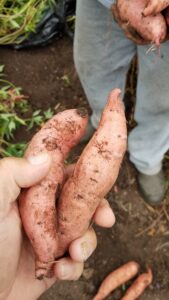 This photo shows the harvest coming from the plants grown out in the field. Very desirable size, shape and color. Great for fresh market sales and not to big for restaurant sales as well.
This photo shows the harvest coming from the plants grown out in the field. Very desirable size, shape and color. Great for fresh market sales and not to big for restaurant sales as well.
Since COVID restricted the part of the project where we going to hold a training demonstration for other growers, this is still something we want to do. There is one grower that we "talked" through the process over the phone and with emails. They will be taking their first cuttings in early May.
Education & Outreach Activities and Participation Summary
Participation Summary:
Consultations included meeting with fellow sweet potato growers to discuss and share techniques of hilling, mulching, fertilizing methods, and irrigation.
I provided input to Cornell Cooperative Extension Master Gardeners Program on growing sweet potatoes for course curricula.
Learning Outcomes
Project Outcomes
I had about the same amount of sales this season as last. I'm going to try and get more orders next season ,and work on my timing. When things get back to normal and we get a vaccine, I hope to get involved in some training opportunities.
My goal is to produce a weekly crop ready to sell from mid-May to mid-June. This goal includes growing 1200 sweet potatoes/cuttings, 48 per flat in 25 flats.*
*(Using sprouted method mentioned under "Research"; still need to identify right number to fit in flat.)
Another objective is storing the cured potatoes. An insulated tent with environmental controls for humidity and temperature would increase shelf life. This initiative may require additional storage trays.
Timing is key to having plants ready for customers. I now have a good idea of how long it takes to from cuttings to crop sales. The part of the timing I'm working on is getting potatoes to sprout. I'll report on my planned new method of incubating in my final report.
